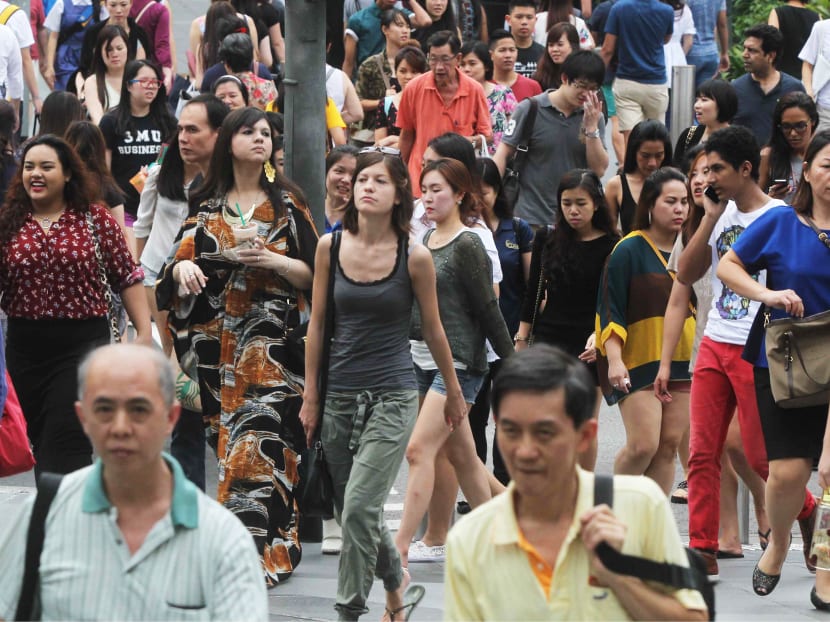S’pore’s population growth slowest in a decade
SINGAPORE — Despite the number of births last year matching a decade-high achieved in 2012, the Republic’s population grew at its slowest pace in more than 10 years — inching up by 1.2 per cent to reach 5.54 million as of June.

The proportion of working adults between 20 and 64 years supporting senior citizens fell further to 4.9 this year, down from 5.2 last year and 5.5 in 2013. TODAY file photo
SINGAPORE — Despite the number of births last year matching a decade-high achieved in 2012, the Republic’s population grew at its slowest pace in more than 10 years — inching up by 1.2 per cent to reach 5.54 million as of June.
The annual Population in Brief report — issued today (Sept 30) by the National Population and Talent Division (NPTD) — showed that the number of citizens grew by 1 per cent over the past year to reach 3.38 million while the number of permanent residents remained stable at about 530,000.
The growth of the non-resident population — it stands at 1.63 million as of June — slowed from 2.9 per cent last year to 2.1 per cent. This was due to “concrete steps” to slow the growth of Singapore’s foreign workforce, NPTD said. In all, about 23,000 foreign workers were added to the labour force between June 2014 and June this year. In comparison, 33,000 more foreign workers came to Singapore in the preceding one-year period.
Last year, there were 33,193 citizen births while marriages involving at least one citizen reached a 17-year high at 24,037.
However, the citizen population continues to age, as more post-war baby boomers enter the older age groups. The median age of citizens has risen to 40.7 years, up from 40.4 last year. About 13.1 per cent of citizens were aged 65 and above as of June, up from 12.4 per cent last year.
Correspondingly, the proportion of working adults between 20 and 64 years supporting senior citizens - or the citizen old-age support ratio - fell further to 4.9 this year, down from 5.2 last year and 5.5 in 2013.
The inflow of foreign manpower was a hot topic during the 2011 General Election, and since then, the Government has tightened its foreign worker policy. It has said that there will be no U-turn on the tight lid on foreign worker numbers here.
NPTD noted that businesses will continue to face a tight labour market. “The government will support businesses to shift towards skills- and capital-intensive ways to grow, so that businesses can continue to grow and succeed here, to create quality jobs for Singapore,” it said.
Economists and sociologists whom TODAY spoke to reiterated that Singapore cannot afford to close its doors to immigration and foreign labour, and policymakers have to continue to calibrate the inflow as the Republic pushes on with efforts to raise the productivity of a leaner workforce.
SIM University senior lecturer Walter Theseira said it is a conundrum that has no easy solution. Said Dr Theseira: “Are we getting that growth from productivity? The answer unfortunately is not to the extent we would like. Can we do better? Yes but how? If we knew how to get there, we would have definitely done that by now. I think neither the government nor businesses know what the magic solution is to productivity and they’ve tried but it’s a difficult problem to solve.”
While the Government has been seeking to bring in foreign labour who are higher-skilled, it is not as straightforward as it seems, he said.
“Even if you set out to bring in higher-skilled manpower, you bring in quite a lot of medium-skilled manpower who have skills which are quite common or replicated among the Singapore population,” he added.
Institute of Policy Studies research fellow Christopher Gee felt the focus should be on bringing in foreign workers who can help raise productivity and add value - but not in the narrow sense. “Just because you bring in a low skilled worker, it doesn’t necessarily mean that the value-add that the worker creates will be low. They might work on an infrastructure project that generates a lot of value in future. So from that perspective, it’s about understanding how that worker can contribute to the economy in a sustainable and long-term manner,” said Mr Gee.
National University of Singapore (NUS) sociologist Paulin Straughan said there is a concern whether there are enough bodies in the workforce to “ensure and sustain a vibrant economy”. “The implications of the more stringent immigration rules that have been put in place has resulted generally in faster ageing of the population,” she said.
Associate Professor Straughan, who had spoken previously about the rising trend of transnational marriages, reiterated the need to look at ways to better integrate foreign spouses and children of these families into the local population and workforce.
About 37 per cent of all marriages involving citizens last year were transnational marriages. The proportion has held steady at about four in 10 of all marriages between 2004 and 2014.






